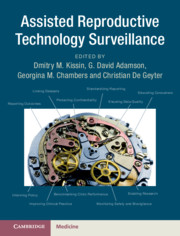Book contents
- Frontmatter
- Contents
- Foreword
- List of Contributors
- Section 1 Introduction to ART Surveillance
- Section 2 General Principles of ART Surveillance
- Section 3 Using ART Surveillance Data
- 5 Reporting ART Success Rates
- 6 Using ART Surveillance Data in Clinical Research
- 7 Monitoring ART Safety and Biovigilance
- 8 Quality Assurance of ART Practice: Using Data to Improve Clinical Care
- 9 Monitoring Long-Term Outcomes of ART: Linking ART Surveillance Data with Other Datasets
- 10 Use of ART Surveillance by People Experiencing Infertility
- Section 4 Global Variations in ART Surveillance
- Section 5 Surveillance of Non-ART Fertility Treatments
- Appendix A ART Surveillance System Variables and Definitions
- Appendix B International Glossary on Infertility and Fertility Care
- Appendix C ICMART Data Collection Form
- Index
- Plates
5 - Reporting ART Success Rates
from Section 3 - Using ART Surveillance Data
Published online by Cambridge University Press: 14 June 2019
- Frontmatter
- Contents
- Foreword
- List of Contributors
- Section 1 Introduction to ART Surveillance
- Section 2 General Principles of ART Surveillance
- Section 3 Using ART Surveillance Data
- 5 Reporting ART Success Rates
- 6 Using ART Surveillance Data in Clinical Research
- 7 Monitoring ART Safety and Biovigilance
- 8 Quality Assurance of ART Practice: Using Data to Improve Clinical Care
- 9 Monitoring Long-Term Outcomes of ART: Linking ART Surveillance Data with Other Datasets
- 10 Use of ART Surveillance by People Experiencing Infertility
- Section 4 Global Variations in ART Surveillance
- Section 5 Surveillance of Non-ART Fertility Treatments
- Appendix A ART Surveillance System Variables and Definitions
- Appendix B International Glossary on Infertility and Fertility Care
- Appendix C ICMART Data Collection Form
- Index
- Plates
Summary
The increasing complexity and variation in ART laboratory and clinical practice, together with a recognition of the importance of patient-centered outcomes, makes ART registries a central resource for informing patients, regulators and governments about the performance of ART treatment. The sequential nature of ART treatment gives rise to a multitude of possible numerators and denominators for measuring treatment outcomes. Which combination of these is the most appropriate and important depends on the stakeholder perspective and the purpose of the measure. ART registries are used in a number of countries to measure ART performance, particularly for reporting at a fertility clinic level. While health data transparency generally leads to better decision making, the process of measurement itself has the potential to both positively and negatively alter the behavior of clinics and clinicians. Finally, personalized patient predictor tools developed using large registry datasets are becoming common and are likely to become an important tool to assist clinicians in counselling patients about their individual chances of ART success.
- Type
- Chapter
- Information
- Assisted Reproductive Technology Surveillance , pp. 37 - 46Publisher: Cambridge University PressPrint publication year: 2019



